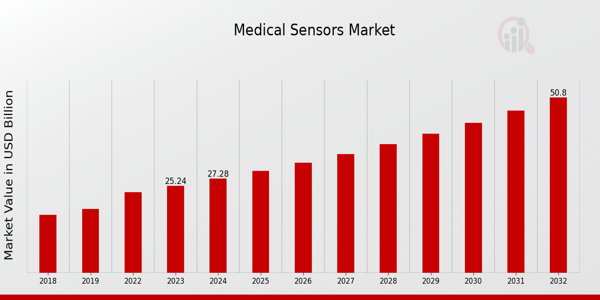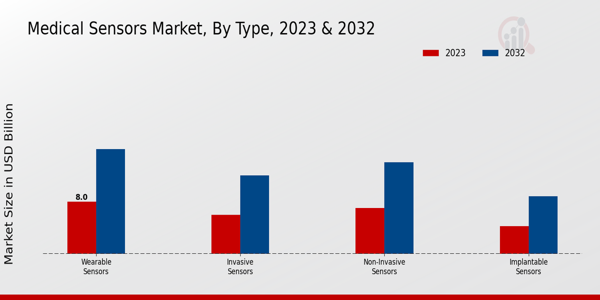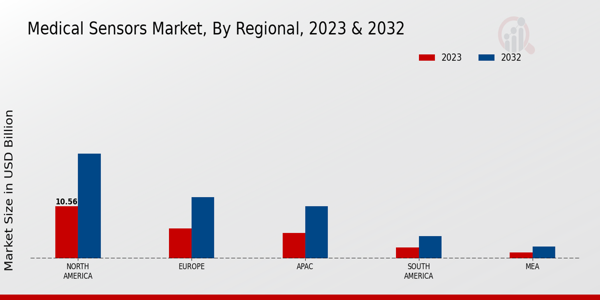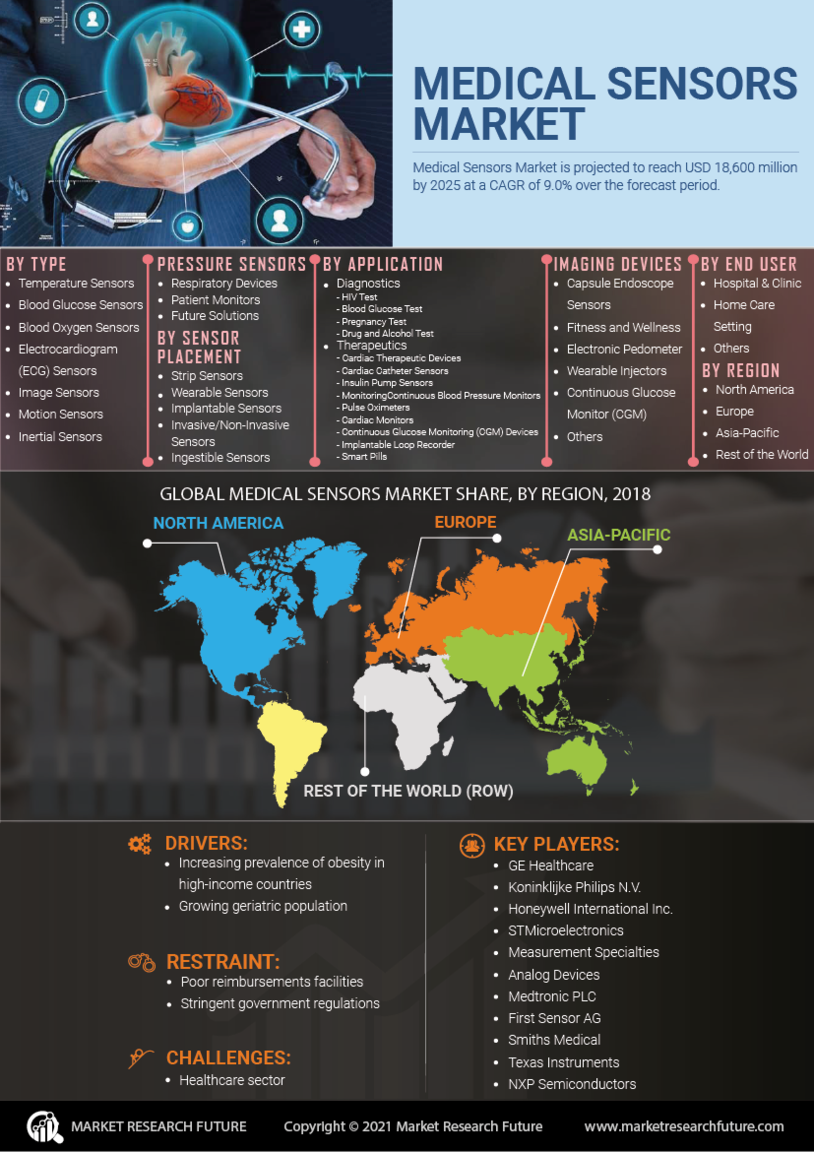Medical Sensors Market Overview
As per MRFR analysis, the Medical Sensors Market Size was estimated at 23.1 (USD Billion) in 2023.The Medical Sensors Market Industry is expected to grow from 24.42(USD Billion) in 2024 to 45 (USD Billion) by 2035. The Medical Sensors Market CAGR (growth rate) is expected to be around 5.71% during the forecast period (2025 - 2035)
Key Medical Sensors Market Trends Highlighted
Technological developments and changing healthcare requirements are driving notable trends in the Global Medical Sensors Market. Key market drivers include the rising incidence of chronic illnesses, which calls for improved monitoring strategies. This development is driving the need for medical sensors, enabling real-time health monitoring and management. The increasing elderly population worldwide also drives more need for creative healthcare solutions, hence strengthening the necessity for dependable medical sensors. The use of artificial intelligence and machine learning in medical equipment will help to maximize commercial possibilities.
These technologies seek to increase diagnosis accuracy, hence improving patient outcomes. Moreover, the growing popularity of telehealth and remote patient monitoring creates opportunities for more general usage of medical sensors. Given that healthcare systems all over are striving toward digital transformation, businesses can look into alliances to improve these devices' features. Driven by consumer desire for personal health management tools, wearable medical sensors have gained attention in recent years. These gadgets encourage active involvement in patients' wellness journeys by allowing them to monitor their health parameters easily.
The worldwide rise of telemedicine has sharpened attention to creating tiny sensors and wireless technologies, thereby offering customers quick and easy choices for health monitoring. These trends draw attention to a dynamic scene guiding the Global Medical Sensors Market toward a bright future where technological innovation meets patient-centric care.

Source: Primary Research, Secondary Research, MRFR Database and Analyst Review
Medical Sensors Market Drivers
Increasing Demand for Remote Patient Monitoring
Particularly motivated by the continuing worldwide health issues like the COVID-19 pandemic, the Global Medical Sensors Market Industry is seeing a rise in demand for remote patient monitoring solutions. Governments and healthcare institutions have given telemedicine top priority, hence allowing people to track their health from home. A World Health Organization research underlined that telehealth use increased by 79% in the early stage of the epidemic, suggesting a rising acceptability of distant treatment alternatives.
Medical sensors targeted for diabetes control, cardiovascular health, and vital signs monitoring have been creatively developed in response to this trend. Philips and GE Healthcare are two companies actively broadening their product offerings in these fields, therefore greatly helping the market to grow as they create sophisticated sensors enabling real-time health monitoring, which is vital for Global efficient healthcare delivery.
Technological Advancements in Sensor Technology
Rapid developments in sensor technology are functioning as a primary driver for the Global Medical Sensors Market Industry. Medical incorporation of Internet of Things (IoT) technology is facilitating better data collection and processing, hence improving patient outcomes. The National Institute of Health estimates that the market for wearable medical devices, which are very dependent on sophisticated sensors, will develop dramatically, estimating a 25% rise by 2025.
Companies like Abbott Laboratories and Medtronic are leading the way, always creating smaller, more efficient sensors to improve patient care. More healthcare providers are likely to drive the market ahead by using modern technology for improved health management, thereby pushing the industry forward.
Growing Aging Population
One major factor shaping the development of the Global Medical Sensors Market Industry is the aging population worldwide. The United Nations estimates that by 2050, the world's population aged 65 and above will double from 703 million in 2019 to 1.5 billion. This demographic change results in a greater frequency of chronic illnesses and age-related health concerns, which in turn drives the need for dependable medical sensors to track diabetes and heart disease, among other disorders.
The CDC and other agencies are aggressively encouraging the use of medical sensors to improve the quality of life for seniors. As they create creative solutions to cater to the health demands of the aging population, this trend points to a strong market potential for firms like Siemens Healthineers and Bosch Healthcare.
Regulatory Support and Funding for Medical Technology
Government policies and regulatory assistance for medical technology development are driving expansion in the Global Medical Sensors Market Industry. Regulatory agencies like the U.S. Food and Drug Administration (FDA) have hastened the approval process for creative medical devices, hence promoting research and commercialization. Furthermore, projects like the European Union's Horizon 2020 program have invested significantly in healthcare advances, emphasizing sensor-driven solutions.
These financing initiatives are expected to raise spending on medical sensor research and development by around fifteen percent by 2030. Major players, including organizations like the National Institutes of Health, are funding these activities, ensuring that the industry stays oriented towards ongoing development and innovation in medical sensor technology.
Medical Sensors Market Segment Insights
Medical Sensors Market Application Insights
The Global Medical Sensors Market has outlined a comprehensive segmentation focused on Application, which includes critical areas such as Wearable Devices, Monitoring Systems, and Diagnostic Imaging. In 2024, the overall market valuation is expected to reach approximately 24.42 USD Billion, with significant contributions from its various applications. Wearable Devices are projected to generate a valuation of 8.0 USD Billion in the same year, and it is anticipated to grow to 15.0 USD Billion by 2035, thus indicating the increasing reliance on personal health monitoring solutions.These devices have gained traction for their ability to provide real-time health data, thereby empowering individuals to manage their health proactively. Monitoring Systems are also seeing substantial market traction, with expected valuations of 9.0 USD Billion in 2024 and projected growth to 16.5 USD Billion by 2035. The demand for these systems is being driven by the growing emphasis on patient-centric care and the need for continuous health monitoring, particularly in chronic disease management contexts.Moreover, Diagnostic Imaging applications, valued at 7.42 USD Billion in 2024, are expected to rise to 13.5 USD Billion by 2035.The importance of this segment cannot be overstated, as it not only enables precise diagnostic capabilities but also supports advancements in treatment planning, making it significant in the healthcare continuum. Trends such as telehealth and remote patient monitoring are acting as growth drivers across all segments, while challenges such as data privacy concerns and integration with existing healthcare systems persist. Overall, the Global Medical Sensors Market segmentation clearly reflects the dynamic landscape of healthcare technology, presenting both challenges and opportunities for industry stakeholders as they navigate this evolving ecosystem.The market growth in these application areas signals a robust shift towards smarter, more connected healthcare systems that prioritize patient outcomes. As we look ahead to 2035, these segments will play crucial roles in shaping the future of healthcare delivery on a global scale, supported by advances in technology and increased consumer awareness regarding health management.

Source: Primary Research, Secondary Research, MRFR Database and Analyst Review
Medical Sensors Market Type Insights
The Global Medical Sensors Market is expected to be valued at 24.42 billion USD in 2024, showcasing significant growth potential. The market is structured around various types of sensors, including Temperature Sensors, Pressure Sensors, Image Sensors, and Biosensors, each playing a crucial role in healthcare applications. Temperature Sensors are vital for monitoring patients' body temperature, contributing significantly to clinical settings. Pressure Sensors are essential for cardiovascular monitoring and medical device functionalities, holding substantial importance in the diagnostics domain.Image Sensors facilitate advanced imaging technologies such as MRI and CT scans, enhancing diagnostic precision. Biosensors, which measure biological responses for medical analysis, dominate the field due to their critical role in point-of-care testing and chronic disease management. The market is driven by technological advancements and rising healthcare expenditures globally. However, it also faces challenges like regulatory constraints and the need for standardized protocols. Overall, the Global Medical Sensors Market segmentation reveals diverse applications and robust potential for innovation and growth in improving patient outcomes on a global scale, with increasing adoption across various healthcare sectors.
Medical Sensors Market End Use Insights
The Global Medical Sensors Market is experiencing significant growth as it caters to various end-use applications including Hospitals, Home Care, Diagnostic Laboratories, and Research Institutions. By 2024, the overall market is projected to reach a value of 24.42 USD Billion, with a steady growth trajectory leading to an expected valuation of 45.0 USD Billion by 2035. Hospitals represent a vital segment, utilizing medical sensors for patient monitoring and diagnostics, which enhances the quality of care provided. Home Care has gained traction, driven by the increasing preference for remote health monitoring and personalized patient management.Diagnostic Laboratories play a critical role in the accurate evaluation of health conditions, where advanced sensors are instrumental in testing and analysis. Similarly, Research Institutions leverage these sensors to facilitate innovative studies and breakthrough discoveries. The continual evolution in medical technology, coupled with an aging population and rising healthcare expenditure, propels the Global Medical Sensors Market growth, presenting opportunities for advancements in sensor capabilities and integration within healthcare systems.The demand for high-precision sensors in these segments highlights their importance, ensuring effective healthcare delivery and improved patient outcomes across the globe.
Medical Sensors Market Sensor Technology Insights
The Global Medical Sensors Market is poised for significant growth, with a valuation of 24.42 USD Billion expected in 2024. Sensor Technology plays a crucial role in this market, driving advancements in medical diagnostics and patient monitoring systems. The market encompasses various types of sensors, including Electrochemical, Optical, Thermal, and Micro-electromechanical Systems. Electrochemical sensors are vital for monitoring blood glucose levels and other analytes, showcasing their importance in diabetes management and chronic disease monitoring.Optical sensors dominate in non-invasive monitoring applications, providing real-time feedback to healthcare providers. Thermal sensors are essential for accurate temperature measurements, making them crucial in both clinical and home healthcare settings. Micro-electromechanical Systems contribute to miniaturization and integration of sensors into wearable devices, enhancing patient mobility and comfort. The overall market growth is fueled by rising demand for personalized healthcare solutions, increasing incidence of chronic diseases, and advancements in sensor technologies, despite challenges such as high initial costs and regulatory hurdles.With opportunities for innovation, the Global Medical Sensors Market is on track to reach 45.0 USD Billion by 2035, reflecting the growing integration of sensor technology in the healthcare industry.
Medical Sensors Market Regional Insights
The Global Medical Sensors Market exhibits diverse regional characteristics, with North America leading with a valuation of 10.0 USD Billion in 2024, projected to rise to 18.0 USD Billion in 2035, showcasing a significant demand for advanced healthcare technologies and increased health monitoring initiatives. Europe follows as another substantial player, holding a market value of 7.0 USD Billion in 2024, expected to reach 13.0 USD Billion by 2035, driven by stringent regulatory requirements and a growing aging population. The Asia-Pacific (APAC) region has a lower initial valuation of 4.0 USD Billion in 2024, with projections of 8.0 USD Billion in 2035, attributed to rapid urbanization and increasing healthcare expenditure.South America stands at 2.0 USD Billion in 2024, forecasted to grow to 3.5 USD Billion by 2035, reflecting a growing investment in healthcare infrastructures. Lastly, the Middle East and Africa (MEA) starts at 1.42 USD Billion in 2024, with estimates reaching 2.5 USD Billion in 2035, highlighting the regions' needs for improved healthcare systems in developing economies. The significance of these regional dynamics underpins the Global Medical Sensors Market revenue, driven by technological advancements and demographic shifts across continents.The balance among these regions reflects varied investment priorities, yet collectively contributes to the market growth in the medical sensors landscape.

Source: Primary Research, Secondary Research, MRFR Database and Analyst Review
Medical Sensors Market Key Players and Competitive Insights
The Global Medical Sensors Market has been experiencing significant growth due to the increasing demand for advanced healthcare solutions, rising prevalence of chronic diseases, and the ongoing technological advancements in sensor technologies. Various players in the market are focusing on developing innovative products that can improve patient monitoring, diagnostics, and treatment outcomes. The competition within this space is intensifying as companies strive to enhance their offerings through strategic collaborations, mergers, product launches, and geographical expansions, ensuring they capture a substantial market share. As consumer expectations evolve, companies must adapt swiftly to the changing landscape while also addressing regulatory challenges and maintaining high standards in product reliability and safety.Abbott Laboratories has carved a notable presence in the Global Medical Sensors Market by leveraging its strong research and development capabilities to introduce innovative health technologies. The company is known for its extensive range of medical devices, particularly in glucose monitoring systems and continuous glucose sensors. Abbott's strength lies in its commitment to improving patient outcomes through continuous innovation and ensuring high-quality products. With a robust global distribution network, the company has established itself as a trusted name among healthcare providers and patients alike. Abbott Laboratories actively seeks to enhance its product portfolio and expand its market presence worldwide, positioning itself as a leader in the medical sensors domain and making significant investments to stay ahead in a highly competitive field.NXP Semiconductors also plays a crucial role in the Global Medical Sensors Market with its advanced sensor solutions designed for healthcare applications. The company is recognized for its innovative semiconductor technologies that facilitate precise data acquisition and processing in medical devices. By providing a wide range of products, including sensing solutions for monitoring vital signs and enabling connectivity in medical applications, NXP Semiconductors ensures that it meets the evolving needs of healthcare systems. With a strategic focus on merging and acquiring other technology leaders, NXP has enhanced its capabilities and strengthened its market presence globally. The company’s commitment to research and development enables it to deliver cutting-edge solutions that enhance the functionality and efficacy of medical devices. Together with its partnerships and collaborations, NXP Semiconductors is positioned to be a favorable contender in the global market, contributing to the advancement of healthcare technologies.
Key Companies in the Medical Sensors Market Include
- Abbott Laboratories
- NXP Semiconductors
- Bosch Sensortec
- STMicroelectronics
- Philips
- Roche
- GE Healthcare
- Maxim Integrated
- Microchip Technology
- Texas Instruments
- Analog Devices
- Medtronic
- Honeywell
- Omron
- Siemens Healthineers
Medical Sensors Market Industry Developments
The Global Medical Sensors Market is currently experiencing significant developments, particularly with advancements in technology and strategic partnerships among key players. Recently, Abbott Laboratories announced the launch of its latest continuous glucose monitoring system, enhancing diabetes management for patients globally in September 2023. In terms of acquisitions, in August 2023, Siemens Healthineers acquired Varian Medical Systems to strengthen its position in the oncology space, which is expected to enhance Siemens' diagnostic and therapeutic capabilities. Additionally, Honeywell has expanded its healthcare sensors portfolio, featuring innovations aimed at improving patient monitoring systems through smart technology. The growing aging population and increasing prevalence of chronic diseases are driving demand for advanced medical sensors that provide accurate and real-time data. Furthermore, in June 2022, Philips invested significantly in R&D to develop wearable health technologies, reflecting the company’s commitment to enhancing healthcare delivery through innovative medical sensors. Amid these changes, the global medical sensors market is projected to experience substantial growth, fueled by technological advancements and increasing healthcare investments, thereby transforming patient care and clinical outcomes across various regions.
Medical Sensors Market Segmentation Insights
-
Medical Sensors Market Application Outlook
- Wearable Devices
- Monitoring Systems
- Diagnostic Imaging
-
Medical Sensors Market Type Outlook
- Temperature Sensors
- Pressure Sensors
- Image Sensors
- Biosensors
-
Medical Sensors Market End Use Outlook
- Hospitals
- Home Care
- Diagnostic Laboratories
- Research Institutions
-
Medical Sensors Market Sensor Technology Outlook
- Electrochemical
- Optical
- Thermal
- Micro-electromechanical Systems
-
Medical Sensors Market Regional Outlook
- North America
- Europe
- South America
- Asia Pacific
- Middle East and Africa
| Report Attribute/Metric Source: |
Details |
| MARKET SIZE 2023 |
23.1(USD Billion) |
| MARKET SIZE 2024 |
24.42(USD Billion) |
| MARKET SIZE 2035 |
45.0(USD Billion) |
| COMPOUND ANNUAL GROWTH RATE (CAGR) |
5.71% (2025 - 2035) |
| REPORT COVERAGE |
Revenue Forecast, Competitive Landscape, Growth Factors, and Trends |
| BASE YEAR |
2024 |
| MARKET FORECAST PERIOD |
2025 - 2035 |
| HISTORICAL DATA |
2019 - 2024 |
| MARKET FORECAST UNITS |
USD Billion |
| KEY COMPANIES PROFILED |
Abbott Laboratories, NXP Semiconductors, Bosch Sensortec, STMicroelectronics, Philips, Roche, GE Healthcare, Maxim Integrated, Microchip Technology, Texas Instruments, Analog Devices, Medtronic, Honeywell, Omron, Siemens Healthineers |
| SEGMENTS COVERED |
Application, Type, End Use, Sensor Technology, Regional |
| KEY MARKET OPPORTUNITIES |
Wearable health monitoring devices, Telemedicine integration growth, Rising demand for remote diagnostics, Advancements in sensor technology, Increased health awareness globally |
| KEY MARKET DYNAMICS |
Technological advancements, Rising demand for home healthcare, Increasing prevalence of chronic diseases, Growing need for early diagnosis, Expanding healthcare infrastructure |
| COUNTRIES COVERED |
North America, Europe, APAC, South America, MEA |
Medical Sensors Market Highlights:
Frequently Asked Questions (FAQ) :
The Global Medical Sensors Market is expected to be valued at 24.42 USD Billion in 2024.
By 2035, the market is anticipated to reach a value of 45.0 USD Billion.
The Global Medical Sensors Market is expected to grow at a CAGR of 5.71% from 2025 to 2035.
North America is projected to dominate the market with a value of 10.0 USD Billion in 2024.
The market size for Europe is expected to reach 13.0 USD Billion by 2035.
Wearable Devices are expected to be valued at 8.0 USD Billion in 2024 and 15.0 USD Billion by 2035.
The market for Monitoring Systems is projected to be 9.0 USD Billion in 2024 and reach 16.5 USD Billion by 2035.
Major players include Abbott Laboratories, GE Healthcare, Medtronic, and Philips.
The market for Diagnostic Imaging is expected to be valued at 7.42 USD Billion in 2024 and 13.5 USD Billion by 2035.
The APAC region is projected to have a market size of 8.0 USD Billion by 2035.

















